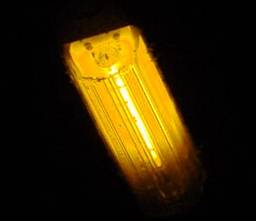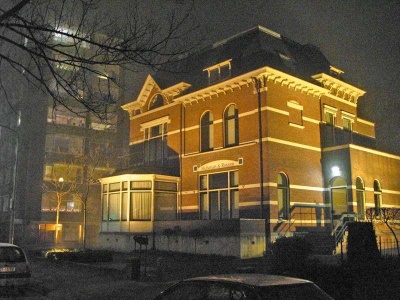Discharge lighting
Sodium & Mercury discharge lights are used for outdoor lighting. They are widely used as streetlights, and are effective for always-on lighting of large areas.
They are highly energy efficient, but the quality of light is poor.
Metal halide offers good quality white light, but is not as energy efficient as sodium.
General Information
The advantages of sodium are extreme energy efficiency and very long lamp life. The disadvantages are poor light quality and slow warm up.
Mercury is much more energy efficient than halogen lamps, but less than sodiums. Mercury lamps are the lowest cost discharge lamps and make good replacements for halogen where light quality is not a priority and on times are long. Linear fluorescent lights may also be a suitable option in such situations.
Metal halide lamps are costly, but total cost is still less than filament lamps such as halogen, due to their much better energy efficiency.
Discharge lamps (light bulbs) are typically relatively expensive to buy, but cheap and highly energy efficient to run. They are very long lived, which minimises relamping.
Sodium & mercury lamps take minutes to warm up. Hence they can not be used on PIR detectors.
Discharge lights must be run from a suitable ballast, never connect a bulb direct to the mains. The ballast is built into the fitting.
Sodium lights are available from 18w upwards. An 18w lamp will light more than the average drive or yard.
Light types
Metal Halide
- Good quality white light
- Available in warm white 2700K and daylight 4000-5000K
- Much better light quality than sodium & mercury lamps
- Relatively high purchase cost
Mercury
- Ice cold white light
- Start time under a minute
- Sometimes used as street or car park lights, but sodium has become more popular.
Low pressure sodium (SOX)
- Pure yellow light
- Start time in the region of 9 minutes
- Exceptional energy efficiency
- Often used to light motorways
High pressure sodium (SON)
- Gives an orangey / golden / pink light.
- Start time in the region of 2 minutes
- Often used as town centre street lights.
Modified Sodium Lamps
SON +
These modified sodium lamps give slightly better CRI and output than standard SON lamps.
- Fit in standard SON luminaires
White Sodium
These produce a golden whitish light, and are another modification of the high pressure sodium lamp.
- Require their own type of control gear
SOX +
Slightly improved SOX lamp
SOX Economy
Improved energy efficiency over standard SOX when run on hf control gear
Colour Perception
Under low pressure sodium light, since only one colour is produced, vision is monochrome, meaning no perception of an object's colour is possible. The viewer's perception of colour under these lights is due to light from other sources, memory, and the awareness that greens and blues will look dark while orange and yellow appear light.
High pressure sodium produces a wider spread of colours, but still an incomplete spectrum. Much more colour perception is possible. Red orange yellow and green are visible, but blue is almost absent.
Mercury discharge lamps produce white light, but the spectrum is not high CRI, and the relative brightness or intensity of different colours is not natural. Although this is the closest of the 3 to white light, it is a perceptually less pleasant light than high pressure sodium.
The combination of both mercury and high pressure sodium lamps gives a much better quality of light than either lamp alone. To be visually acceptable, the 2 lamps must be in the same place, hence this strategy is best suited to high positioned lamps lighting large areas.
Metal halide lamps give a true white light.
For more information on the spectra of these lamps and the implications for vision, see
Luminous Efficacy
Typical figures, in lumens per watt. Filament lamp performance is included for comparison.
- 180 Low pressure sodium
- 110-150 High pressure sodium
- 50-125 Metal halide
- 35-60 Mercury discharge
- 10-17 Filament
Fittings
Control gear is built in to the fitting.
- Sodium lamps run on sodium lamp control gear
- Mercury lamps run on mercury lamp control gear
- Metal halide lamps: some use sodium control gear, some use mercury lamp control gear
Transplant
Discharge lighting fittings typically look more industrial than domestic. 18w SOX fittings that look like bulkhead lights are available.
If you want something that looks better, the contents of an ugly fitting can be transplanted to a fitting of your choice.
- Buy the necessary luminaire for your chosen lamp
- Buy the light fitting you want to transplant the lamp into
- Transplant the bulb holder from luminaire to chosen fitting
- Connect the 2 with mains flex
- Mount the luminaire somewhere out of sight
Note:
- Transplants are only for sodium and mercury.
- Don't try to transplant metal halide.
- The starting voltages involved are much too high for non-purpose designed fittings and cable.
- Metal halide fitting must be able to contain exploding bulbs.
- The wattage rating of the light fitting should exceed that of the lamp being used.
- Don't use a fitting with a mirror finish reflector, this can cause lamp overheating. Light scattering reflectors are ok.
- Do not attempt to operate discharge lamps from PIR sensors. Timers and dawn to dusk sensors are suitable.
For SON and mercury only:
- Keep the wire between ballast and bulb short.
- This wire will have to cope with high voltage starting pulses with some of these lamp types, so use a heavy mains flex.
Igniters
Some lamps have internal ignitors, some external. The 2 lamp types can not be swapped in fittings.
- Letter I in a triangle means internal igniter
- Letter E in a triangle means external
Uses
Discharge lights are mostly used for lighting large yards and warehouses, and of course street lighting.
The absence of low output discharge lamps and poor light quality makes them unsuitable for pretty much all indoor lighting.
Discharge lamps are also used for plant lighting. Sodium is used where its light will be mixed with daylight. The lower efficiency mercury is generally preferred where it is used in the absence of daylight, since sodium lacks significant blue output.
When sodium is used for plant lighting, high light levels, strong flicker, very poor colour perception and low visual contrast make working under the lighting for a length of time mildly unpleasant. When long working times are expected, wearing coloured glasses can improve this by blocking some of the yellow light, thus improving colour, excess brightness and contrast.
Lighting Options
For domestic use a PIR operated 150w halogen lamp or better a few PIR operated CFLs are generally the best option. They give white light and are only on a small amount of the time. 500w of halogen is much too bright for the majority of houses.
Mounting a halogen high up reduces glare. Mounting it within reach of a window makes relamping easy.
If a PIR light would spend a lot of time on in your situation, a low power sodium lamp on a timer and/or a dawn-dusk sensor may produce lower total energy use and less bulb changes. The price is lower light quality.
For large yards a good policy is often a combination of minimal low pressure sodium lighting plus halogen or CFL on PIRs.

